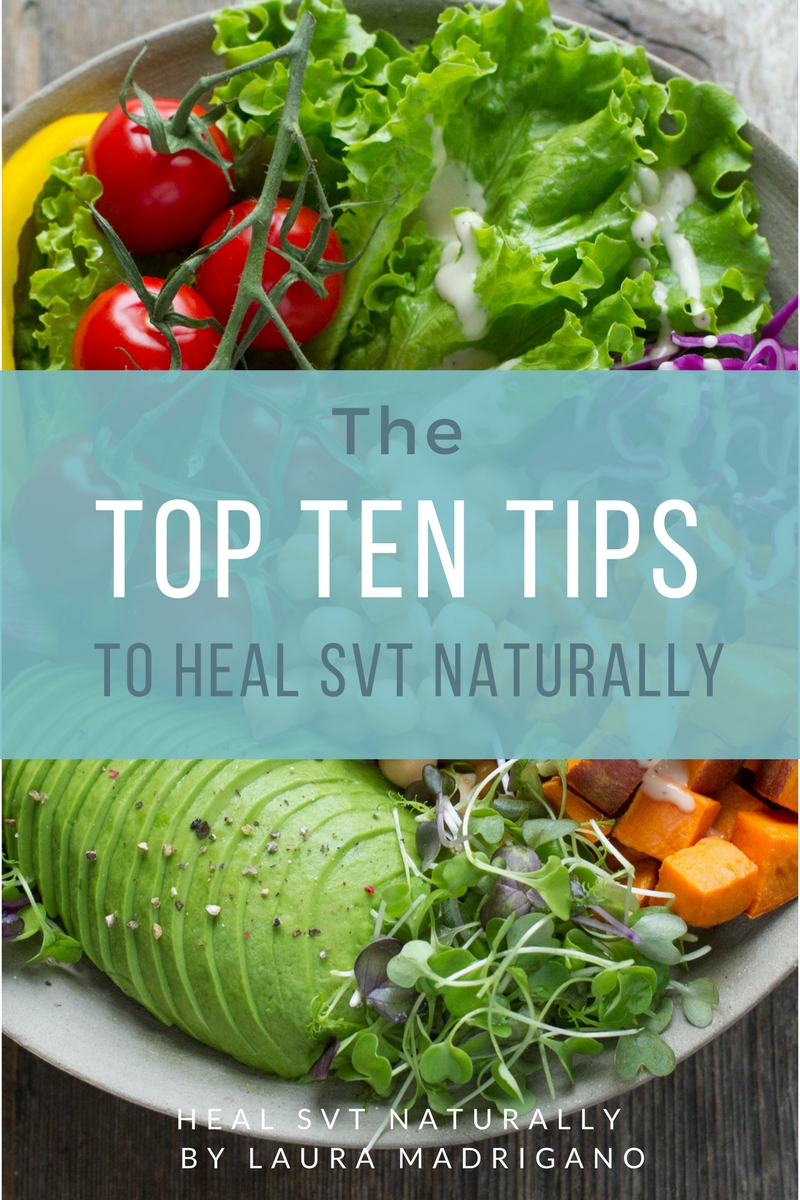Is Gluten Your Mysterious Link to SVT?
by Sharon Goldner from the Meet the Experts Series 
Last month I shared my experience as Laura Madrigano’s health coach and the beginning of her life-changing journey of healing. As you know, this provided the inspiration to her blog writing and led her to help hundreds (if not thousands) of others with SVT and related health issues.
The first and most important step Laura took was to get tested for gluten intolerance and commit to a completely gluten-free diet once it was determined that she carried the genes. The rest is history, as they say.
Perhaps gluten is also the missing piece for you, the mysterious link sitting in plain sight? It’s easy enough to find out. This week’s blog is intended to give you the basic facts about what and where gluten is, its many symptoms and how to find out if this is your story too.
What is Gluten?
Gluten is the generic name for certain types of proteins contained in wheat, barley, and rye, and also found in oats because of cross-contamination through harvesting or processing. When someone who cannot tolerate gluten eats foods containing that substance, it creates an immune reaction that causes damage to the small intestine, and an inflammatory response that can travel beyond the gut to any organ in the body. Even small amounts of gluten in foods can damage the small intestine and trigger many sorts of health problems even if one doesn’t appear to have symptoms.
Gluten-Intolerance includes the subsets of celiac disease (CD) and non-celiac gluten sensitivity (NCGS), which are genetic predispositions affecting people of all ages and ethnicities.[1] People with CD have flattened villi in their small intestines after repeated exposure to gluten, whereas people with NCGS do not have this autoimmune response. People with both types of conditions require a gluten-free diet, and can experience almost all of the same symptoms throughout the body.
Gluten is Everywhere!
We generally consume more gluten than we realize, since a lot of it is hidden and unnoticeable. Consider this:
- Food manufacturers add gluten to wheat flours to give it more binding power. This is why our breads and bagels are so chewy and tasty.
- Gluten is a common additive in many packaged, bottled and canned foods. It enhances the texture by binding, thickening or coating the food.
- Today’s bioengineers cultivate grains with high amounts of gluten in order to improve the end product. It is estimated that wheat today contains almost 90% more gluten than it did 100 years ago![2]
- Wheat, barley and rye derivatives exist in foods where you might not expect to find them: soy sauce, salad dressings, processed meat, soups, candy, alcohol and flavored coffee, to name a few of the many thousands of such products.
Are You Gluten-Intolerant?
It is estimated that there are nearly 200 problems that someone who cannot tolerate gluten may experience (that SVT is not on this list shows you that the research is still evolving, and some of you are proof of gluten’s impact). A person with a gluten-intolerance may have none, one, or several of these conditions. This type of disorder is difficult to diagnose without testing because you may not be aware that you have symptoms, or that they are related to each other. Therefore, if someone with SVT has at least a few of the symptoms below, it could be further reason to believe that it’s all connected. It’s also complicated because these problems can have other causes unrelated to gluten, they may be worsened by gluten, or they may be caused by gluten.
A partial list of problems or conditions caused or worsened by gluten in people with gluten intolerance:[3]
Digestive
Acid reflux
Bloating
Canker sores
Constipation
Diarrhea
Fructose intolerance
Irritable bowel syndrome
Lactose intolerance
Liver disease
Pancreatitis
Steatorrhea (fatty floating stools)
Skin
Acne
Alopecia areata (hair loss)
Eczema
Dry skin
Psoriasis
Dark circles under eyes
Emotional
Anxiety
Irritability
Depression
Physical wellbeing
Fatigue
Difficulty losing or gaining weight
Poor endurance
Chronic fatigue
Failure to thrive
Short stature
Mind/Neurological
Autism
ADHD
Mental fog
Insomnia/difficulty sleeping
Epilepsy
Musculoskeletal
Arthritis
Fibromyalgia
Muscle aches/joint pains
Osteopenia/osteoporosis
Respiratory
Wheezing
Chronic sinusitis
Asthma
Women’s Health
Irregular cycle
Infertility
Miscarriage
Headaches/migraines
Miscellaneous
Anemia
Raynaud’s disease (cold hands/feet)
Autoimmune disorders
Hashimoto’s disease
Lupus (SLE)
Thyroiditis
Confirming a Diagnosis
There are now specialty laboratories that can perform accurate testing for celiac disease (CD) and non-celiac gluten sensitivity (NCGS). I recommend Entero Lab (www.enterolab.com) which does not require a prescription and sends the testing kit directly to the consumer. They offer a $149 genetic test with a cheek swab that will tell you if you inherited one or two (or no) gluten genes from your parents. This also has implications for the people who are genetically related to you. In addition, Entero Lab offers a stool test (very easy to do) that measures your sensitivity or immune response to gluten and other common foods such as soy, yeast, dairy, eggs and various meat, grains, nuts. There are many test combinations top choose from which you can discuss with their customer service.
You can also test your sensitivity to gluten by completely eliminating it from your diet for 30 days to assess whether it makes a difference in any of your symptoms. However, you have to be 100% free of gluten in order to be certain of the outcome. Be prepared that many people experience a detox, or malaise, when they initially remove gluten from their diet, which could be discouraging or confusing. Ultimately, if you feel better without gluten, then it is a good indication that a gluten-free diet would serve you well. Please note that a laboratory test needs to detect antibodies from the gluten in order to be accurate. Therefore, if you truly eliminate gluten several months before testing, it may be too late to take a test. Discuss it with the lab.
Given that many SVT sufferers are gluten-intolerant, I believe it is a good investment to get tested. You will discover whether gluten is NOT your problem and you are very blessed; or it is the key to finding life-long health and happiness. And it will quiet the “doubters” and all of the people who challenge your decision to change your diet.
This is a lot of information to digest (pun intended!). Feel free to ask follow up questions on this blog, or contact me privately at recipeforahealthylife@gmail.com
[1] Ludvigsson, Jonas F., Daniel A. Leffler, Julio C. Bai, Federico Biagi, Alessio Fasano, et al. “The Oslo Definitions for Coeliac Disease and Related Terms.” Gut Online. Feb 16, 2012. Vol. 62, no. 1, pp. 43-52. <http://gut.bmj.com/content/62/1/43. full?sid=918fd8f0-bed7-4695-a274-0b102c2ce847>.
[2] Lieberman, Shari. The Gluten Connection: How Gluten Sensitivity May Be Sabotaging Your Health – And What You Can Do to Take Control Now. New York: Rodale Books. 2007. P. 2.
[3] Wangen, Stephen. Healthier Without Wheat: A New Understanding of Wheat Allergies, Celiac Disease, and Non-Celiac Gluten Intolerance. Seattle: Innate Health Publishing. 2009. P. 37.
Gluten Free, Dairy Free Seasonal Dessert
Check out my favorite fall delicious dessert: Fruit Crisp. Here’s the link: http://recipeforahealthylife.com/apps/recipe/details/id/Fruit-Crisp






Recent Comments